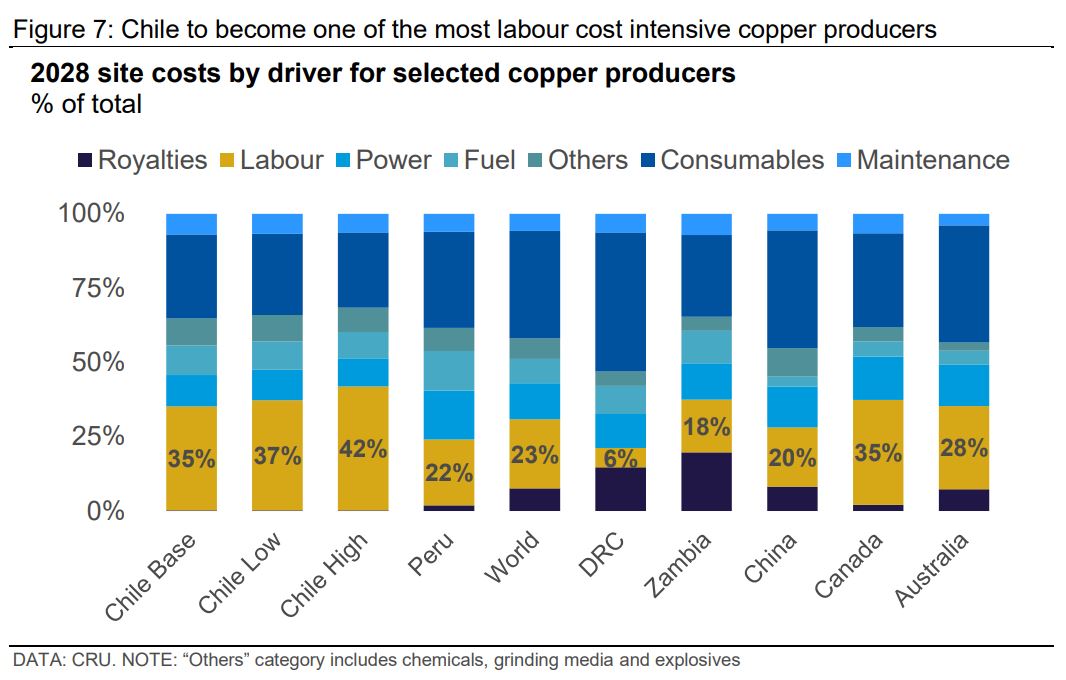Chile's parliament approved a reform that reduces the working week from 45 to 40 hours, which is widely expected to be signed into law by presidential decree during April. The copper industry – the country's largest by GDP contribution and exports – could see labour cost increases over 9%, which, other factors remaining equal, would make the country's assets less competitive, pushing them higher on the cost curve. CRU estimates the measures would lift Chile’s mining industry costs by 4% in 2028 against the current base case (without the reform in place). The new law would bring Chile's unit labour cost closer to developed countries, making it more exposed to labour cost fluctuations, as labour costs constitute over 37% of the cost base.

The reform was broadly supported from all political sectors
The law to reduce the maximum weekly working hours from 45 to 40 – first discussed in 2017 – was recently approved by the Chilean Congress. Although the discussion was slowed down due to the drafting of a new constitution and the economic situation, it recently gained momentum with the election of President Boric in 2022.
The law is now waiting for its official enactment by the President within April this year. The regulation now will allow for compensation for overtime in certain industries and will be implemented gradually over five years, with the 40-hour limit reached in 2028.
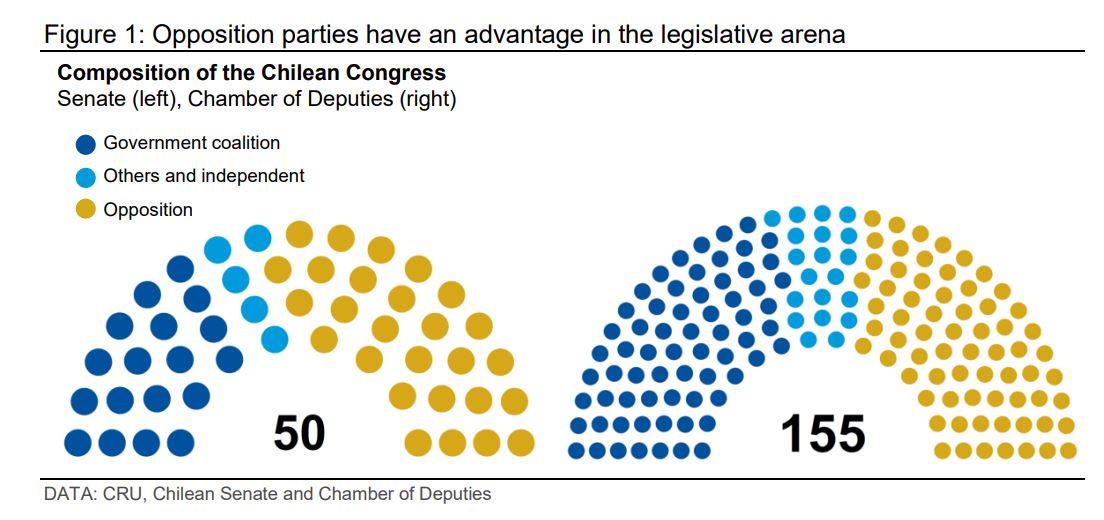
The draft bill was approved in April 2023 with cross-cutting support in Congress, despite the government coalition – the sponsors of this initiative – being in the minority. The regulation is popular with the electorate and has broad political support, despite economic uncertainty and electoral pressures. In May 2023, elections for Constitutional Advisors will be held, which has created tension in the legislative discussion due to the electoral stakes involved.
Copper mining is a driving force for jobs in Chile
Chile's mining sector employs around 270,000 workers, with almost a quarter being direct workers in production and the rest being contractors in service companies, suppliers, engineering, and more. While mining jobs only represent 3% of national employment, in regions where mining is concentrated, like Antofagasta and Atacama, one fifth of employment comes from mining. In other mining regions, this figure is 7%.
Over the last 20 years, there has been a consistent relationship between copper prices and the number of workers in the sector, with a one-year lag. This relationship is especially consistent for contractors, who can be hired with less long-term commitment.

Higher costs and shifts in employment dynamics
Labour in the mining industry in Chile has many characteristics that make it different from other productive sectors. Therefore, the impacts of the proposed law could also be distinct from the rest of the economy.
Copper production is a process that requires operational continuity, meaning that there is no downtime in the mining process. Workers normally work 12-hour shifts, over periods of ‘7x7’ days (7 working and 7 resting days), ‘4x3’, and less frequently ‘14x14’.
Expressing the typical mining work patterns on a weekly basis, the average number of hours worked under the 7x7 and 4x3 systems is 42.5 hours per week, 2.5 hours above what the regulation will establish by 2028.
With the full deployment of the draft law in 2028, that is, implementing 40-hour working weeks, and as explained above, the following possible scenarios will emerge for the mining sector:
- Low case scenario: Mining companies will have to compensate time above 40 hours as overtime, at 50% above the normal hourly rate. CRU considers this the most likely scenario and implies an increase in labour costs of 9.4%, other factors remaining equal.
-
High case scenario: Given the need for operational continuity, companies put in place an additional shift of workers to meet the 40-hour week. This is an unlikely scenario and implies a 33.3% increase in labour costs, setting the upper bound.
-
Other scenarios: There are other intermediate scenarios, where companies could adopt a mix of compensating overtime, outsourcing activities, and adjusting shift times, however, this would imply a higher cost increase than the low case scenario.
The reform will increase labour costs at Chilean copper operations, leading to an increase in total costs. The expected increase in CRU Value-adjusted cash costs, excluding royalties, ranges from 3.6% (low case) to 12.5% (high case) by 2028. The impact varies at the individual asset level, with labour-intensive operations being more exposed to higher cost increases, ranging from 20% to 50% of site costs.
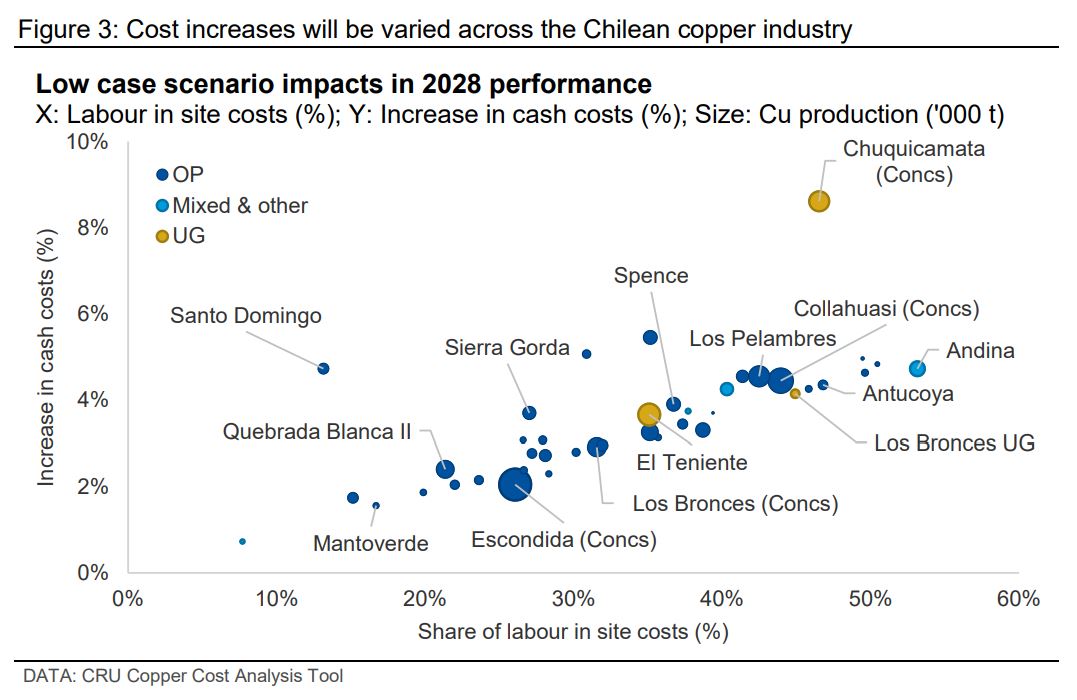
Chile's mining industry is in the 3rd quartile of the CRU cost curve globally, with competitive large-scale operations like Escondida and Collahuasi in the 1st and 2nd quartile, and smaller, higher-cost mines in the upper half of the curve. The base scenario predicts that 735,000 tonnes of copper production will be above the 90th percentile in the 2028 cost curve, comprising 12.0% of the country's production and mostly consisting of SX-EW mines and smaller scale operations.
The high scenario could shift nearly 200,000 tonnes of production above the 90th percentile (P90) threshold, representing 15.5% of Chile's 2028 production, while the low scenario would not affect any operations.
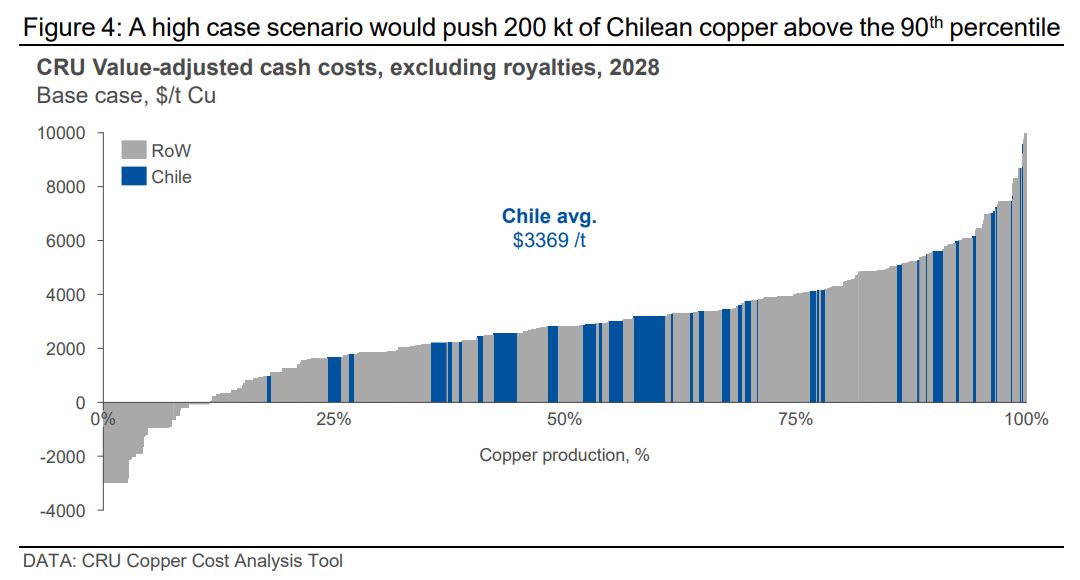
For the low case scenario, the main changes in the positioning of Chilean assets take place in the central segment of the global cost curve, with a shift of almost 370,000 tonnes from the 2nd to the 3rd quartile.
More dramatically, the high case scenario induces a generalised shift of Chilean production towards the high-cost end of the curve, especially sharp in the transition from the 3rd to the 4th quartile.
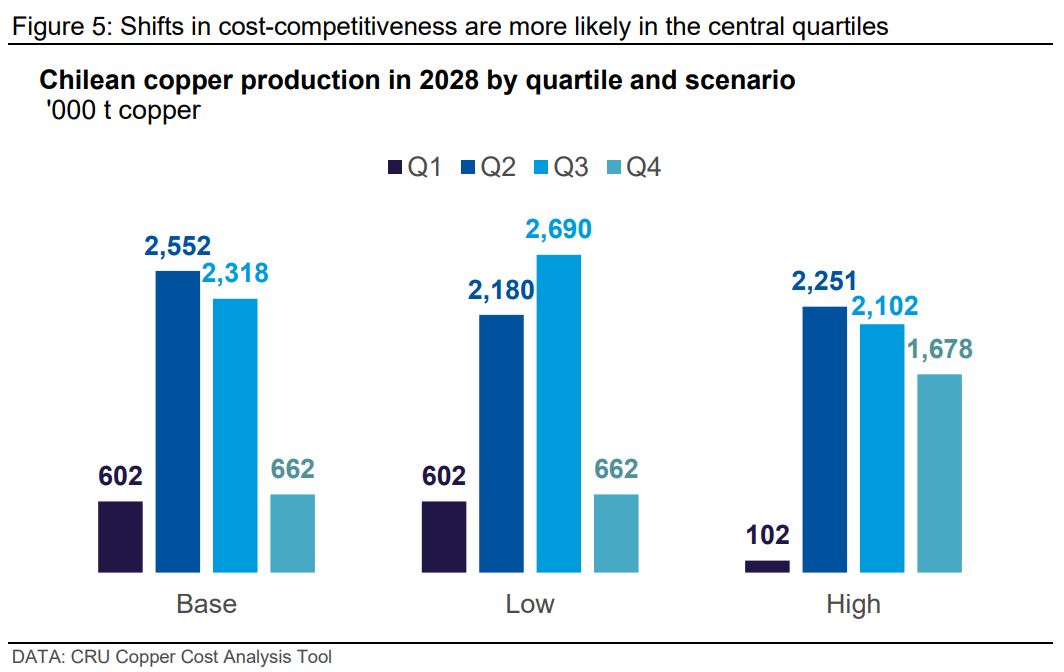
Evidence based on historical data from Chile suggests mining employment is not wage elastic, meaning labour demand reacts less dramatically to wage increases. But sustained wage increases coupled with market downturn could prompt re-evaluation of labour intensity. In the long-term, higher wages may lead to headcount reductions as companies invest more in technological innovations, such as automated operations among others.
Chile’s labour costs would inch closer to developed peers
The table below compares the most common mine work shifts and typical weekly hours for selected copper-producing countries. Countries with a maximum working week of 40 hours or less, like Chile once the reform is fully implemented, often allow longer working hours for mining operations due to remote location or necessary operational continuity. However, reducing working time by more than 10% can have a major impact without measures to increase productivity to compensate.
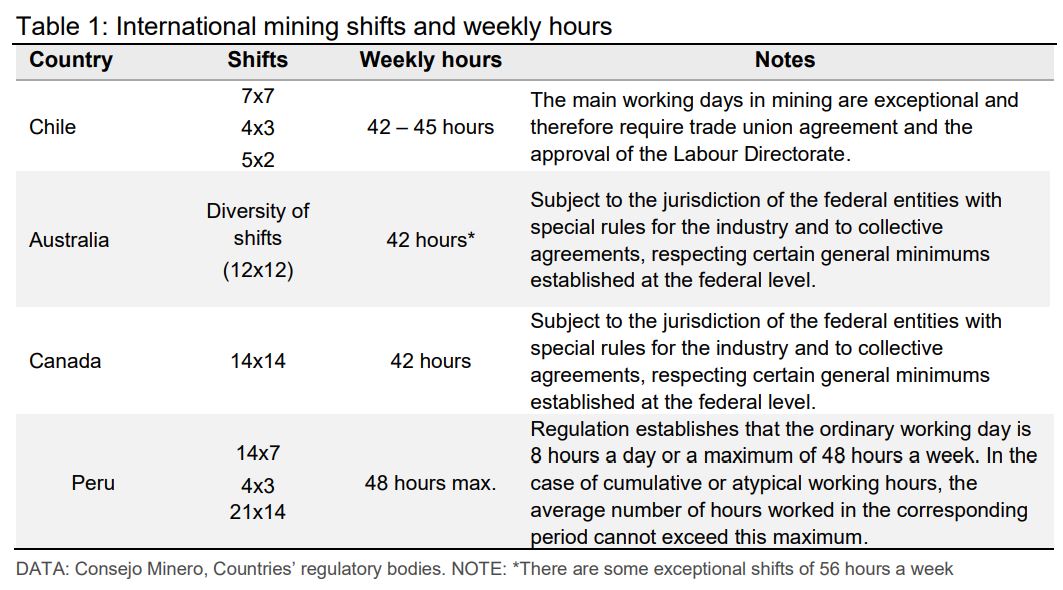
Chile's labour costs are in the mid-range when compared to other major mining competitors, such as Australia and Canada. When evaluating different scenarios on how the new reform could affect these expenses, a slight increase resulting from the reform can be noted, edging Chile’s costs towards the segment of more developed countries.
Chile's mature mining industry makes labour costs a significant part of its cost structure. Other less developed mining regions may have lower labour costs, but this is often due to lower technical expertise, safety standards, and less advanced labour regulations.
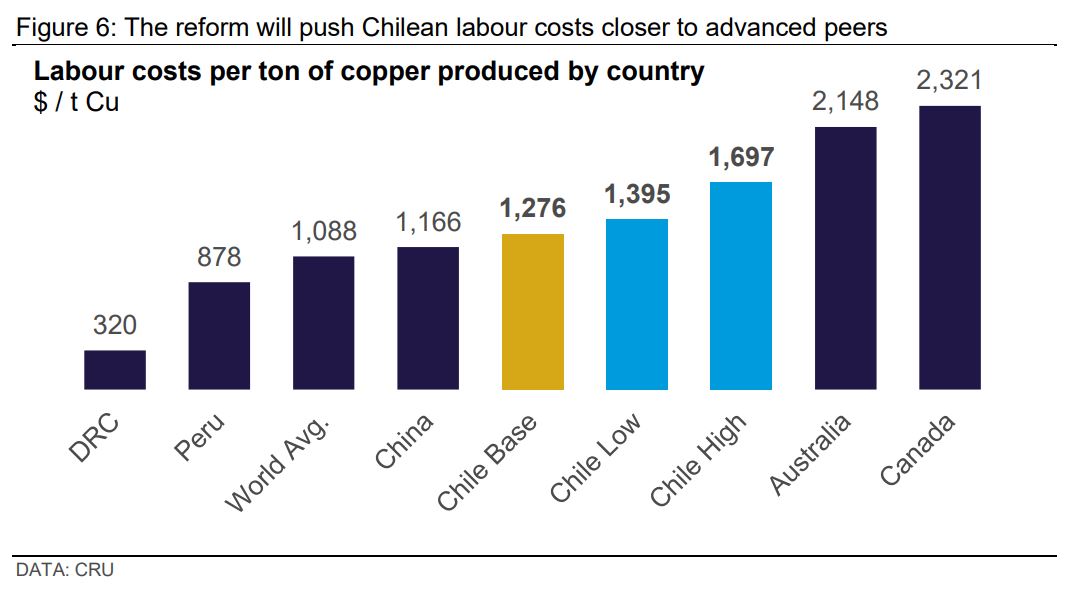
Chile's high labour costs (35% of site costs) will be further amplified by the new reform, making it one of the countries with the highest labour cost shares among copper producers, surpassing Canada and Australia. This increases the industry's exposure to labour cost increases and sensitivity to expenses, given the high unionisation rate and bargaining power of the workers.
